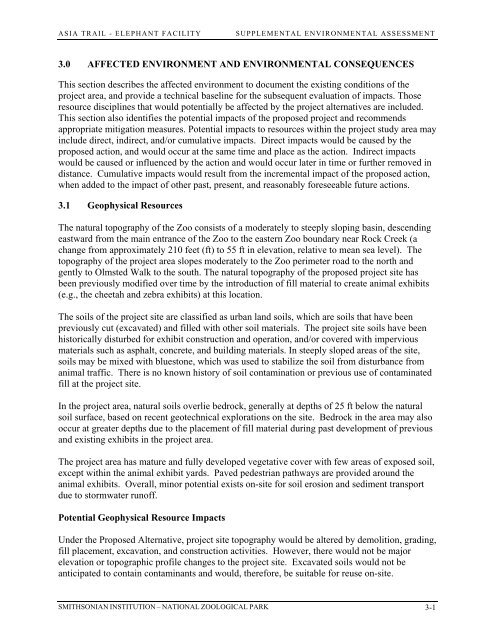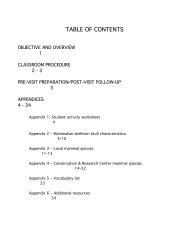asia trail elephant facility - National Zoo - Smithsonian Institution
asia trail elephant facility - National Zoo - Smithsonian Institution
asia trail elephant facility - National Zoo - Smithsonian Institution
You also want an ePaper? Increase the reach of your titles
YUMPU automatically turns print PDFs into web optimized ePapers that Google loves.
ASIA TRAIL - ELEPHANT FACILITY SUPPLEMENTAL ENVIRONMENTAL ASSESSMENT<br />
3.0 AFFECTED ENVIRONMENT AND ENVIRONMENTAL CONSEQUENCES<br />
This section describes the affected environment to document the existing conditions of the<br />
project area, and provide a technical baseline for the subsequent evaluation of impacts. Those<br />
resource disciplines that would potentially be affected by the project alternatives are included.<br />
This section also identifies the potential impacts of the proposed project and recommends<br />
appropriate mitigation measures. Potential impacts to resources within the project study area may<br />
include direct, indirect, and/or cumulative impacts. Direct impacts would be caused by the<br />
proposed action, and would occur at the same time and place as the action. Indirect impacts<br />
would be caused or influenced by the action and would occur later in time or further removed in<br />
distance. Cumulative impacts would result from the incremental impact of the proposed action,<br />
when added to the impact of other past, present, and reasonably foreseeable future actions.<br />
3.1 Geophysical Resources<br />
The natural topography of the <strong>Zoo</strong> consists of a moderately to steeply sloping basin, descending<br />
eastward from the main entrance of the <strong>Zoo</strong> to the eastern <strong>Zoo</strong> boundary near Rock Creek (a<br />
change from approximately 210 feet (ft) to 55 ft in elevation, relative to mean sea level). The<br />
topography of the project area slopes moderately to the <strong>Zoo</strong> perimeter road to the north and<br />
gently to Olmsted Walk to the south. The natural topography of the proposed project site has<br />
been previously modified over time by the introduction of fill material to create animal exhibits<br />
(e.g., the cheetah and zebra exhibits) at this location.<br />
The soils of the project site are classified as urban land soils, which are soils that have been<br />
previously cut (excavated) and filled with other soil materials. The project site soils have been<br />
historically disturbed for exhibit construction and operation, and/or covered with impervious<br />
materials such as asphalt, concrete, and building materials. In steeply sloped areas of the site,<br />
soils may be mixed with bluestone, which was used to stabilize the soil from disturbance from<br />
animal traffic. There is no known history of soil contamination or previous use of contaminated<br />
fill at the project site.<br />
In the project area, natural soils overlie bedrock, generally at depths of 25 ft below the natural<br />
soil surface, based on recent geotechnical explorations on the site. Bedrock in the area may also<br />
occur at greater depths due to the placement of fill material during past development of previous<br />
and existing exhibits in the project area.<br />
The project area has mature and fully developed vegetative cover with few areas of exposed soil,<br />
except within the animal exhibit yards. Paved pedestrian pathways are provided around the<br />
animal exhibits. Overall, minor potential exists on-site for soil erosion and sediment transport<br />
due to stormwater runoff.<br />
Potential Geophysical Resource Impacts<br />
Under the Proposed Alternative, project site topography would be altered by demolition, grading,<br />
fill placement, excavation, and construction activities. However, there would not be major<br />
elevation or topographic profile changes to the project site. Excavated soils would not be<br />
anticipated to contain contaminants and would, therefore, be suitable for reuse on-site.<br />
SMITHSONIAN INSTITUTION – NATIONAL ZOOLOGICAL PARK 3-1
















